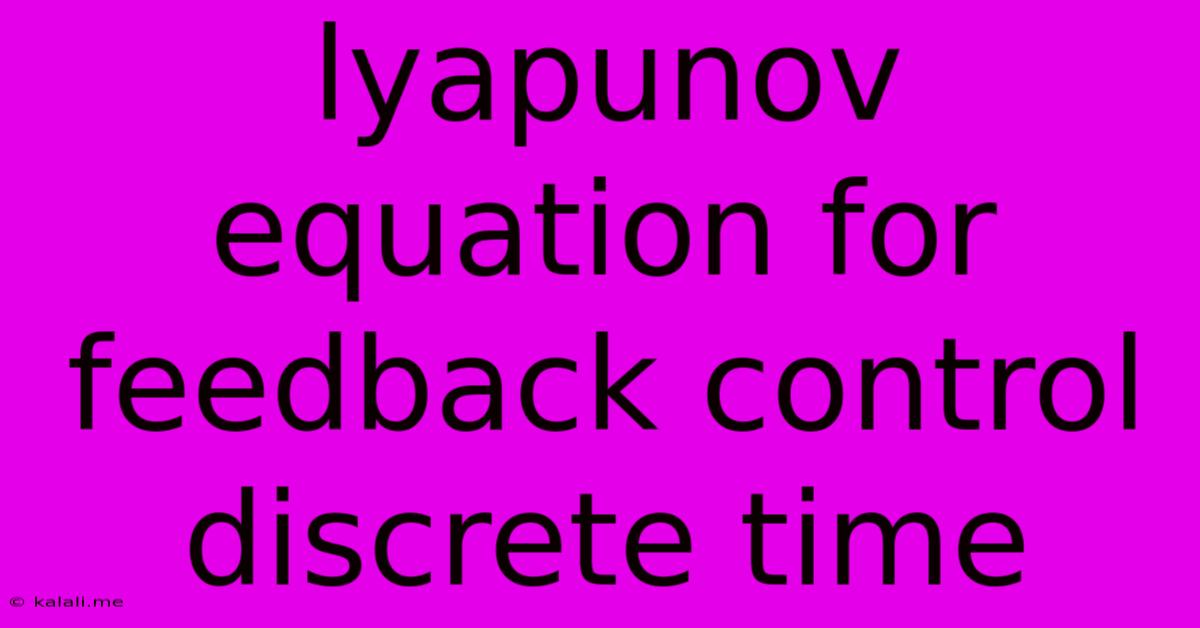Lyapunov Equation For Feedback Control Discrete Time
Kalali
Jun 04, 2025 · 3 min read

Table of Contents
Lyapunov Equation for Feedback Control in Discrete Time
The Lyapunov equation plays a crucial role in stability analysis and controller design for discrete-time systems. This article will delve into its application within the context of feedback control, explaining its significance and providing practical insights. Understanding the Lyapunov equation is essential for determining the stability of a closed-loop system and designing stabilizing controllers. We'll explore its formulation, solution methods, and implications for control system design.
Understanding the Discrete-Time Lyapunov Equation
The discrete-time Lyapunov equation is a matrix equation that relates the system dynamics to its stability properties. It's typically expressed as:
A<sup>T</sup>PA - P + Q = 0
Where:
- A represents the system matrix of the closed-loop discrete-time system (obtained after incorporating the feedback controller).
- P is a symmetric positive definite matrix (the solution we seek). This matrix represents the Lyapunov function.
- Q is a symmetric positive definite matrix. The choice of Q influences the solution and can be used to shape the performance characteristics of the controller. It often represents a weighting on the states.
Stability Analysis using the Lyapunov Equation
The existence of a unique, symmetric, and positive definite solution P for the Lyapunov equation is a necessary and sufficient condition for the stability of the discrete-time system. Specifically:
-
Asymptotic Stability: If a positive definite solution P exists for a given positive definite Q, the closed-loop system represented by matrix A is asymptotically stable. This means that the system's states will converge to zero as time approaches infinity.
-
Instability: If no positive definite solution P exists, the system is unstable.
Therefore, solving the Lyapunov equation is a key step in verifying the stability of a designed controller.
Solving the Discrete-Time Lyapunov Equation
Several methods exist for solving the Lyapunov equation, including:
-
Direct methods: These methods directly solve the matrix equation. However, they can be computationally expensive for large systems.
-
Iterative methods: These methods provide an iterative solution, converging towards the solution P. Examples include the power iteration method and the Bartels-Stewart algorithm. These iterative approaches are often preferred for their efficiency, especially with large-scale systems.
The choice of method depends on factors like the size of the system and computational resources.
Application in Feedback Control Design
The Lyapunov equation isn't just used for verifying stability; it's also instrumental in designing stabilizing controllers. Techniques like Linear Quadratic Regulator (LQR) design inherently involve solving a discrete-time Lyapunov equation to determine the optimal control gain matrix. The LQR approach minimizes a cost function that considers both state and control effort, leading to a controller that stabilizes the system while optimizing performance.
Choosing the Weighting Matrix Q
The selection of the weighting matrix Q is crucial. Different choices of Q result in different solutions for P and hence affect the characteristics of the closed-loop system. For example:
- Larger Q: Typically leads to faster convergence of states to zero, but may result in higher control effort.
- Smaller Q: Results in slower convergence, but may require less control effort.
Careful consideration of this trade-off is essential in designing effective controllers.
Conclusion
The discrete-time Lyapunov equation is a powerful tool for analyzing and designing feedback control systems. Its ability to determine the stability of a closed-loop system and its integration into controller design methods like LQR makes it an indispensable element in control system theory and practice. Understanding its principles and solution techniques is crucial for any control engineer. Further exploration into topics such as robust control and nonlinear systems will build upon this foundational understanding of the Lyapunov equation's role in discrete-time feedback control.
Latest Posts
Latest Posts
-
Theres 104 Days Of Summer Vacation
Jun 06, 2025
-
How Much Prime Rib Per Guest
Jun 06, 2025
-
Gravel Drive Way On Top Of Ol Old Tar
Jun 06, 2025
-
Does Almond Butter Have To Be Refrigerated
Jun 06, 2025
-
Its All Downhill From Here Meaning
Jun 06, 2025
Related Post
Thank you for visiting our website which covers about Lyapunov Equation For Feedback Control Discrete Time . We hope the information provided has been useful to you. Feel free to contact us if you have any questions or need further assistance. See you next time and don't miss to bookmark.